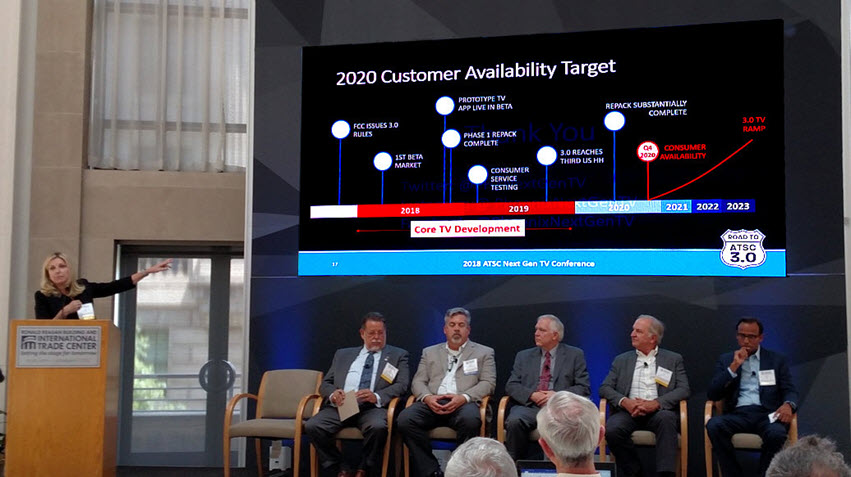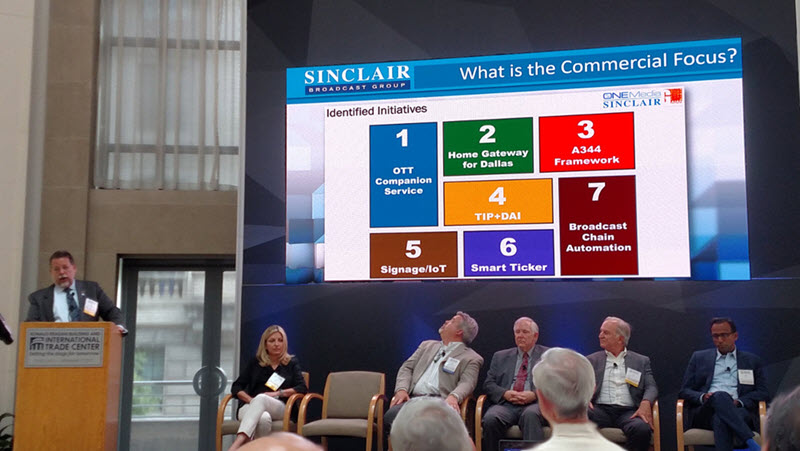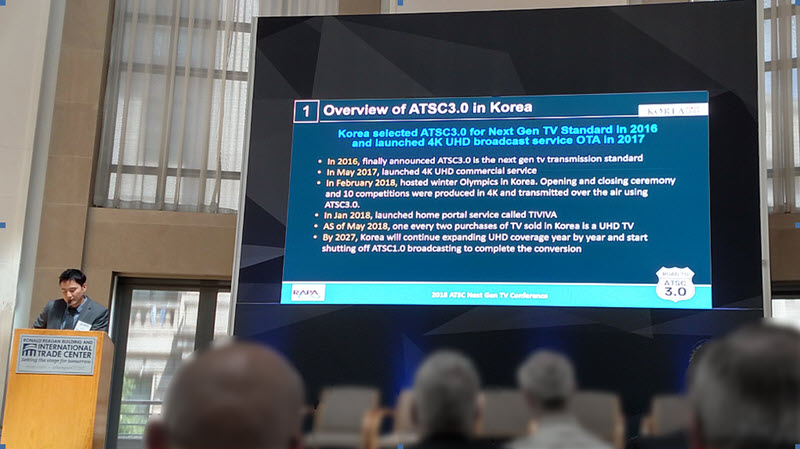The Advanced Television Systems Committee (ATSC) held its 2018 Next-Gen TV Conference last month in Washington, D.C. Speakers at the two-day event reported on its status and provided a forecast on the various business use cases enabled by the new ATSC 3.0 standard.

National Association of Broadcasters (NAB) Chief Technology Officer Sam Matheny delivered the opening keynote, followed by reports on deployments of Next-Generation TV technology in cities that include Phoenix, AZ, Raleigh, NC, Dallas, TX, Cleveland, OH, and East Lansing, MI.
Anne Schelle of Pearl TV (Next Generation Broadcast TV Platform Coming Soon) described the “Lighthouse” transition plan, where one station in each market multicasts the legacy ATSC 1.0 stations, so that viewers without new receivers are not disenfranchised because of the non-backwards-compatible ATSC 3.0 signal. According to Schelle, the biggest hurdle to lighting up the dozen or so stations currently participating in a Phoenix, Arizona ATSC 3.0 trial is that “The FCC doesn’t have forms ready to authorize 3.0 commercial service.”
Nonetheless, in surveys conducted for the Pearl Group, consumer interest in the new features enabled by ATSC 3.0 is “high,” says Schelle, in areas such as personalization and enhanced services.
 Anne Schelle describes ATSC 3.0 rollout in Phoenix, AZ
Anne Schelle describes ATSC 3.0 rollout in Phoenix, AZ
Sinclair VP of Advanced Technology Mark Aitken described the tests going on in Dallas that emphasize automotive, handheld and home-gateway services and applications. He emphasized the home gateway as “the most important piece that has to be developed … and key to monetization opportunities,” with interactivity (per ATSC A/344) and Dynamic Ad Insertion not far behind. Digital signage, where remote displays are addressed by wireless ATSC signals, is also being explored.
 Sinclair’s Mark Aitken describes new business areas under development
Sinclair’s Mark Aitken describes new business areas under development
Pete Sockett, WRAL-TV Director of Engineering and Operations, described the NBC Television Network coverage of the Rio and Pyeongchang Olympics, including 4k transmissions of HDR/WCG content.
Kang Ok Jeon of the Korea Radio Promotion Association (KRPA) gave a special report on the successful launch of ATSC 3.0 broadcasting in South Korea. Services being deployed this year and next include an interactive EPG called TIVIVA, companion screen, dynamic linkage, and public services; push data, targeted ads and personalization are planned for the end of 2019, with 4K UHD nationally by 2021.
Kang said that Korea’s early deployment is serving as an example to other regions, with even Latin America showing interest in NGTV.
 Kang Ok Jeon provides an overview of ATSC 3.0 broadcasts in South Korea
Kang Ok Jeon provides an overview of ATSC 3.0 broadcasts in South Korea
The various ATSC Implementation Teams provided updates on their activities, with Madeleine Nolan, LG Electronics, covering Advanced Emergency Alerting, Dave Siegler, Cox, on ‘Personalization and Interactivity’, and John Lawson moderated a panel discussion about the ‘Advanced Warning and Response Network’ (AWARN).
Day two began with a keynote presentation from Dr. Jeffrey Cole, of the USC Annenberg Center for the Digital Future, who spoke about the evolving role of television. He predicts that “We will consume more TV in the car,” which is becoming the “Second biggest place” for video content consumption. He believes that “content is kinger,” and, for better or worse, TV has become “an all-consuming commitment,” that makes addicts out of viewers, sheepishly admitting he binged on Breaking Bad, watching all 62 episodes in a span of two weeks!
A panel of industry experts from Nielsen, Verance, Ad-ID, the Society of Motion Picture and Television Engineers (SMPTE), and Kantar Media discussed the potential for enhanced Audience Measurement with the new Next-Gen TV standard.
Joe Winograd, Verance, and Arun Ramaswamy, Nielsen, explained that new methods for audience measurement will ensure that an entire connected audience can be measured, across all platforms. This includes a new level of detail that can, for example, segment viewers into more categories than previously possible. ATSC 3.0 provides access to this data through a defined return path, enabling interactivity and dynamic advertising using HTML5, metadata, and audio and video watermarking.
The current state of TV advertising was summarized by Abby Auerbach of the Television Advertising Bureau (TVB), who called NextGen TV “the next “shiny new thing” for consumers. Advertisers are now studying the new capabilities of the standard – personalized home screen and EPG, personalized audio and video, VOD features like shuttle and catch-up TV, personalized ads, and audience measurement – to determine how best to monetize the medium.
 Abby Auerbach of the Television Advertising Bureau describes TV Ad Power
Abby Auerbach of the Television Advertising Bureau describes TV Ad Power
Patrick Butler, President and CEO of America’s Public Television Stations (APTS), gave an afternoon keynote address, where he outlined the opportunities ahead for public broadcasters with the new ATSC 3.0 broadcast standard, including community-centric content delivery, like enhanced emergency alerts.
Looking at new business opportunities, Ed Busby of TEGNA said that “data is the most important part of ATSC 3.0,” and expects a growth in investments in interactivity.
 John Hane, CEO of Spectrum Co LLC, described the new model for cooperative spectrum use being promoted by the joint venture of leading broadcasters. Their plan facilitates a nationwide transition of stations to ATSC 3.0, by aggregating, marketing and selling ancillary data capacity in the ATSC 3.0 signals of member TV stations.
John Hane, CEO of Spectrum Co LLC, described the new model for cooperative spectrum use being promoted by the joint venture of leading broadcasters. Their plan facilitates a nationwide transition of stations to ATSC 3.0, by aggregating, marketing and selling ancillary data capacity in the ATSC 3.0 signals of member TV stations.
The plan includes pooling DTV spectrum in each market, providing a minimum of free over-the-air TV services, and leasing out the remaining bandwidth for data services that will bring in new revenue streams.
The ongoing spectrum auction has slowly whittled away precious spectrum, said Hane, leaving them increasingly in a reactive mode. The business model afforded by his venture, on the other hand, puts broadcasters in control of their spectrum. “Demonstrating active use” of the spectrum is the best tool to substantiate an argument against further broadcast spectrum reduction, he says.
Looking to more futuristic opportunities, Keith Chandler of IBM spoke on the outlook for using Artificial Intelligence (AI) to enhance content consumption. Today, he said, AI is able to produce enhanced metadata for content search and discovery, automatic closed captioning for live or prerecorded content, content recognition, and sports highlight production. On the horizon will be AI-assisted EPGs and formats, and over the horizon we should expect AI-based personal agents to curate specific and individualized content across all of television and the Internet. (AC)

